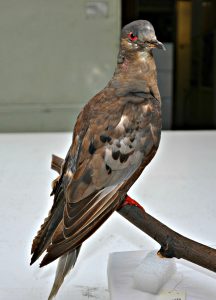The story of the last Passenger Pigeon and the disappearance of the Great Auk, Carolina Parakeet, and Heath Hen reveal the fragile connections between species and their environment. To help tell their story, the Smithsonian Libraries, Biodiversity Heritage Library, and the National Museum of Natural History have curated a joint exhibit entitled Once There Were Billions: Vanished Birds of North America which opened June 24 in the National Museum of Natural History.
Two hundred years ago, the passenger pigeon (Ectopistes migratorius) was the most abundant bird species in North America. A population numbering in the billions, as much as 40% of all land birds on the continent shared the same genome as Martha. Migrating flocks were so large that they literally blocked out the sky, stretching up to a mile wide and 300 miles long and taking 14 hours to pass a single point. Flocks were so densely packed that a single shot could bring down dozens of birds. The beat of up to 3.5 billion pairs of wings literally created its own cold front below, and those unaccustomed to the marvel feared the end of the world was upon them.

Nesting colonies were just as large, covering up to 800 square miles of forest. A single tree often contained up to 100 nests, causing many to topple over at the sheer weight of an aviary kingdom. By the end of the nesting season, blankets of pigeon droppings several inches thick saturated the forest floors. However, while colonies were staggeringly massive, a mating pair of passenger pigeons produced only one, occasionally two, eggs per season.
The passenger pigeon was nearly twice as large as the common city pigeon, with males averaging 16 inches in length and up to 12 ounces in weight. Frames built for speed and maneuverability, the birds could reach up to 60 mph, making them ideal targets for not only hunting parties but simple target practice. The onset of large-scale commercial hunting and railroads for distribution turned a sustainable hunting practice into a frenzied genocide. In 1869, Van Buren County, Michigan, alone shipped 7.5 million passenger pigeons to the east, where they sold for mere pennies.

The dangerous decline of the species was noted as early as the 1850s, but cheap meat and a seemingly endless supply of birds dampened any resolve to implement hunting restrictions. In 1896, a majority of the last wild flock of 250,000 birds were killed during a sporting event heralded as the “last chance to shoot the passenger pigeon in the wild.” On March 24, 1900, a 14-year old boy killed the last known wild passenger pigeon in Pike County, Ohio.
From billions to none in less than 100 years.
Remembering Martha
Passenger pigeon Martha is perhaps one of the most famous animals in the world, for she is a tangible reminder of the human capacity to decimate biodiversity. At nearly 30 years old, Martha, the very last of her species, died at the Cincinnati Zoological Garden at about 1pm on September 1, 1914. Immediately after her death, she was entombed in a 300 pound block of ice and shipped to the Smithsonian, where she was taxidermied.

Millions of people have rallied to commemorate the Passenger Pigeon this year, and help raise awareness about endangered species, extinction, and the impact of human activity on healthy ecosystems. The “Fold the Flock” initiative is an effort to recreate the staggering passenger pigeon flocks of the 19th century through origami pigeons. “The Lost Bird Project” has created a film and book to investigate extinction and memory. Also as part of the project, Todd McGrain has crafted stunning bronze sculptures of extinct birds, including the passenger pigeon, which are on display across America.
Other initiatives like Project Passenger Pigeon, the film From Billions to None, and a multitude of exhibits nationwide are working to raise awareness about extinctions and excite action to prevent future biodiversity calamities.
Finally, as always, the Biodiversity Heritage Library is here to help! Find books about the Passenger Pigeon and illustrations of the species for free from BHL.

One Comment
Can I still send a picture of my passenger pigeon